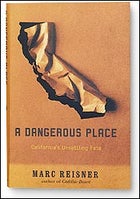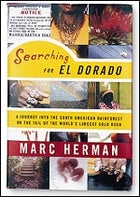THE BIG ONE



A Dangerous Place
California’s Unsettling Fate
BY MARC REISNER
(Pantheon, $22)
MARC REISNER died with paper in his typewriter. When cancer claimed him three years ago (he was only 51), the author of Cadillac Desert, the classic 1986 history of water use in the American West, had his next manuscript nearly completed. Reisner’s widow and his editor polished the rough cut into A Dangerous Place: a seismic warning that reads like dark prophecy from beyond the grave. California’s big earthquake is coming, Reisner says, and it’ll be worse than you think. “The most striking thing about modern California,” he writes, is that “most of its inhabitants have settled, and will continue to settle, where they shouldn’t have.” But Reisner adds a new twist to the usual collapsing-bridges doomsday scenario. Industrial farming has so compacted the soil in the reclaimed marshland of the California Delta, in the northern half of the Central Valley, that the area has become a little Holland: mostly below sea level and kept dry by weak earthen levees. A big quake could destroy those, let the sea in, and create “an 80,000- acre extension of San Francisco Bay.” A Dangerous Place is half elegant history and half elaborately imagined tale of a devastating 2005 quake, and like most posthumous works, it has gaps. But Californians should consider themselves warned. And readers should count themselves lucky for one last chance to hear Reisner speak truth about the West.—Bruce Barcott
SEARCHING FOR EL DORADO
A Journey into the South American Rainforest on the Tail of the World’s Largest Gold Rush
BY MARC HERMAN
(Doubleday, $26)
IN 1994, RECENTLY graduated from college and sans job, budding freelance journalist Marc Herman boarded a bus in Caracas, Venezuela, and headed south to see the Amazon. At a roadside bar on the border of Guyana, he met an older gringo and heard an almost unbelievable story: “The forest around us held five, ten, twenty, maybe fifty billion dollars in gold.” Intrigued, Herman returned to the region several times over the next seven years, investigating huge foreign-owned open-pit mines and documenting the grimy dollar-a-day lives of the country’s hand-miners. His ear is terrific: One 45-page chapter, about a road trip with two bickering miners turned truckers, is a comic masterpiece. But when it comes to gold mining—in Guyana or elsewhere—he finds no easy answers. “Critiques of the mine never suggested a way to replace one-fifth of the national economy,” Herman points out. On the other hand, he writes, “knocking down a forest to produce a virtually useless commodity, of which we already have plenty, makes little sense.” —Rob Buchanan
BAYOU FAREWELL
The Rich Life and Tragic Death of Louisiana’s Cajun Coast
BY MIKE TIDWELL
(Pantheon, $23)
TRAVEL WRITER Mike Tidwell went to Louisiana to write about hitchhiking the bayou on fishing boats and started chasing a bigger story instead: a state collapsing into the sea. “The whole ragged sole of the Louisiana boot, an area the size of Connecticut—three million acres—is literally washing out to sea, surrendering to the Gulf of Mexico,” he writes, and the culprits are big oil and the Army Corps of Engineers. Canals dug for oil and gas pipelines have caused serious erosion, and by harnessing the Mississippi with locks and levees, the Corps has stopped the floods that washed sediment to the bayou; without that replenishment, soil has begun to slip into the Gulf. As a Manhattan-size chunk drowns every ten months, orange groves become fishing holes and a grand Cajun culture is at risk of disappearing. “I’m a fisherman, me, like my daddy and granddaddy,” one old shrimper tells Tidwell. “But de marsh, he’s killin’ us. He just won’t hold togedder anymore. We’ll all be leavin’ here soon, just like de ducks in de spring, everybody moving on.” —B.B.
FLY-FISHING THE 41ST
Around the World on the 41st Parallel
BY JAMES PROSEK
(HarperCollins, $28)
SEVEN YEARS AGO, James Prosek, a virtuoso watercolorist, published a slim, wildly successful volume called Trout: An Illustrated History. Now, at the venerable age of 27, the Yale-educated prodigy is out with his fifth book on the subject, in which he casts and paints his way west to east around the globe following roughly the same latitude as his home in Connecticut. Prosek hooks a 50-pound silure, a catfish-like monster, on the Seine in Paris, pursues the mysterious Tigris trout along the tense Turkey-Iraq border, and lands a long-toothed grayling (a fish not seen by Western scientists for more than 100 years) on a stream in Outer Mongolia. He sometimes strains for literary effect—and his habit of recounting his numerous affairs and near-affairs is sophomoric—but when he sticks to the fishing, Prosek can reel you in. —R.B.
From Mitsuhiko Imamori’s portrait of a tiny spike-headed katydid to Jim Brandenburg’s classic wolf images,
Wildlife: The World’s Top Photographers and the Stories Behind Their Greatest Images
(RotoVision, $35) captures 40 brutal, comic, and jaw-dropping moments in nature. But what really sets this book apart is advice from the hotshots themselves, all of whom give useful tips for capturing your own miracles on film.

